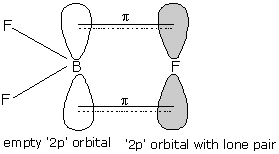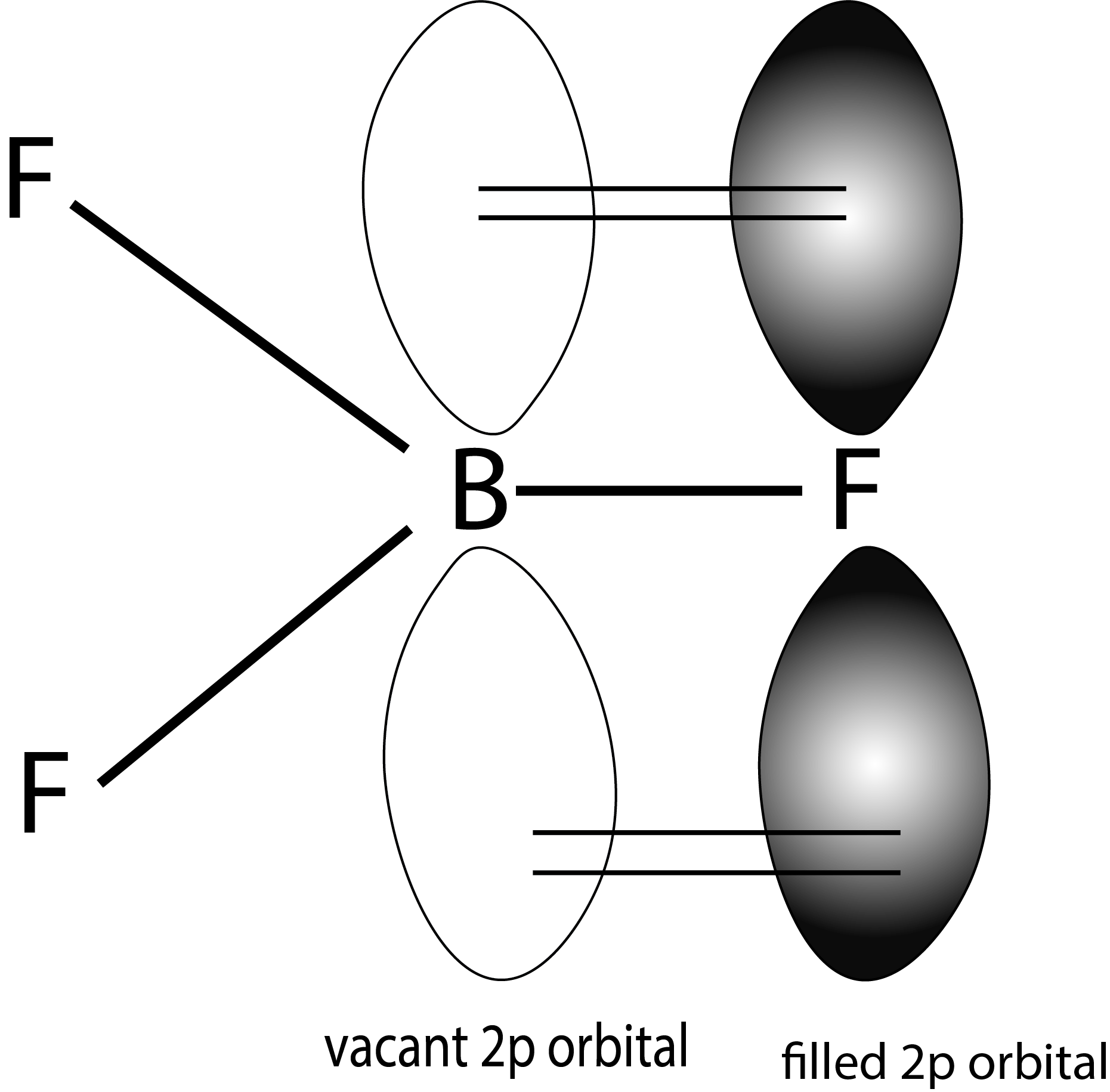
If the $\pi $-backbonding involves the vacant orbital of the central atom, then the bond angle gets widened due to:
(A) The increased bp/bp repulsion for the enhanced bond multiplicity
(B) The decreased of lp/bp repulsion(s)
(C) Both (a) and (b)
(D) None of the above
Answer
572.4k+ views
Hint: During $\pi $-backbonding, one of the bonds will gain bond multiplicity and hence there will be a bond pair - bond pair repulsion created. Widening of the bond angle occurs when there is a greater repulsion between both the bonds.
Complete Step by Step answer:
- During the $\pi$ backbonding, the lone pair is donated to the vacant $\pi$ orbital of the central atom. So, thereby the bond multiplicity increases and hence there is an increased bond pair-bond pair repulsion.

- Above given figure shows the $\pi$ backbonding in the $B{{F}_{3}}$ molecule.
- Here, backbonding is the tendency of halogen atoms to donate electron pairs to boron atoms through $p\pi -p\pi$ bonding.
- Then the electron deficiency of boron decreases and hence, Lewis acidic character also decreases.
- Here, we can see that the bond multiplicity of one of the bonds increases and hence bond pair-bond pair repulsion exists here.
- And hence, the bond angle also increases.
- The decreased bond pair - lone pair repulsion does not contribute to the increment in bond angle.
Hence, the correct answer is Option (A). The increased bp/bp repulsion for the enhanced bond multiplicity.
Additional information:
- Back bonding can be considered to be a type of resonance that is exhibited by several chemical compounds.


- Above given is the representation of resonance structures of $BF_3$, due to backbonding.
- Back bonding also leads to increased stability to the chemical compounds.
- It also affects the overall dipole moment of the molecule and its hybridization.
- $\pi$ backbonding also known as back donation, is a type of back bonding in which the electrons move from the atomic orbital of a given atom into the ${{\pi }^{*}}$ anti-bonding orbital on a ligand ,which is a pi-acceptor.
- $\pi$ backbonding can be most commonly seen in organometallic chemistry, where transition elements form coordinate covalent bonds with polyatomic ligands .
Note: Increased lone pair-lone pair or bond pair-bond pair repulsion leads to the widening of the bond angle but decrement among these won’t make a widening of bond angle.
Complete Step by Step answer:
- During the $\pi$ backbonding, the lone pair is donated to the vacant $\pi$ orbital of the central atom. So, thereby the bond multiplicity increases and hence there is an increased bond pair-bond pair repulsion.

- Above given figure shows the $\pi$ backbonding in the $B{{F}_{3}}$ molecule.
- Here, backbonding is the tendency of halogen atoms to donate electron pairs to boron atoms through $p\pi -p\pi$ bonding.
- Then the electron deficiency of boron decreases and hence, Lewis acidic character also decreases.
- Here, we can see that the bond multiplicity of one of the bonds increases and hence bond pair-bond pair repulsion exists here.
- And hence, the bond angle also increases.
- The decreased bond pair - lone pair repulsion does not contribute to the increment in bond angle.
Hence, the correct answer is Option (A). The increased bp/bp repulsion for the enhanced bond multiplicity.
Additional information:
- Back bonding can be considered to be a type of resonance that is exhibited by several chemical compounds.


- Above given is the representation of resonance structures of $BF_3$, due to backbonding.
- Back bonding also leads to increased stability to the chemical compounds.
- It also affects the overall dipole moment of the molecule and its hybridization.
- $\pi$ backbonding also known as back donation, is a type of back bonding in which the electrons move from the atomic orbital of a given atom into the ${{\pi }^{*}}$ anti-bonding orbital on a ligand ,which is a pi-acceptor.
- $\pi$ backbonding can be most commonly seen in organometallic chemistry, where transition elements form coordinate covalent bonds with polyatomic ligands .
Note: Increased lone pair-lone pair or bond pair-bond pair repulsion leads to the widening of the bond angle but decrement among these won’t make a widening of bond angle.
Recently Updated Pages
Master Class 11 Economics: Engaging Questions & Answers for Success

Master Class 11 English: Engaging Questions & Answers for Success

Master Class 11 Social Science: Engaging Questions & Answers for Success

Master Class 11 Biology: Engaging Questions & Answers for Success

Class 11 Question and Answer - Your Ultimate Solutions Guide

Master Class 11 Business Studies: Engaging Questions & Answers for Success

Trending doubts
What is meant by exothermic and endothermic reactions class 11 chemistry CBSE

10 examples of friction in our daily life

One Metric ton is equal to kg A 10000 B 1000 C 100 class 11 physics CBSE

Difference Between Prokaryotic Cells and Eukaryotic Cells

What are Quantum numbers Explain the quantum number class 11 chemistry CBSE

1 Quintal is equal to a 110 kg b 10 kg c 100kg d 1000 class 11 physics CBSE




